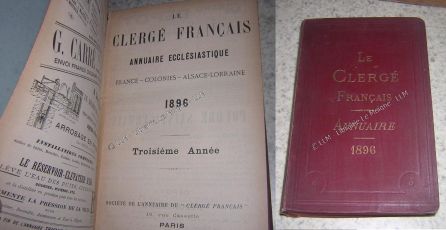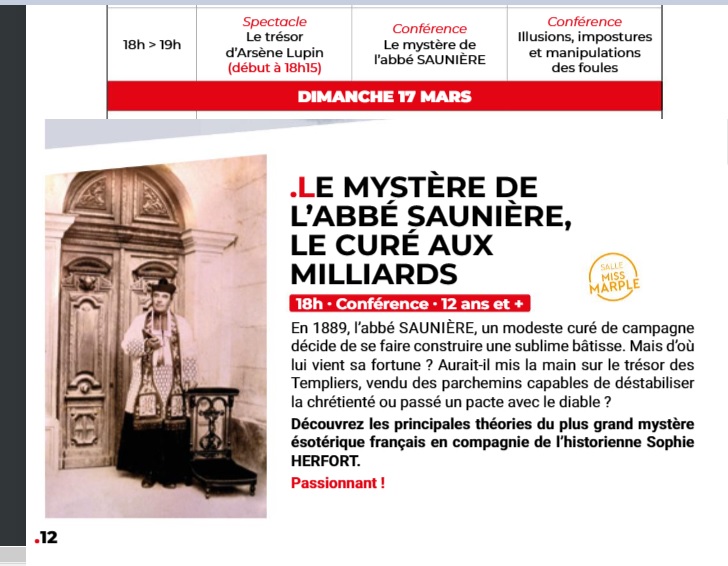The Wealth of Abbé Bérenger Saunière, 1898-1914
Éric Hocquart
28 February 2024
Abbé Bérenger Saunière, the infamous former priest of Rennes-le-Château 1885-1909 – infamous for having his life caricatured by the mythomaniacs, but famous for really accumulating wealth between 1898-1914, is constantly being used as an object of historical ridicule in the same way as “Jack the Ripper” (the murders attributed to him could have been made by different people, with the appellation “Jack the Ripper” most likely being an invention by the London Press used as a gimmick to boost circulation).
Innocent people in ignorance are being introduced to the extravagant and fantastic notions about Saunière (“that he discovered a treasure”), but the real story about him is not that extravagant. In fact, it is quite modest and banal.
Abbé Bérenger Saunière, when he first came to Rennes-le-Château in 1885 lived in some poverty. He got himself suspended from the priesthood for a while with three other priests from the same area for preaching political sermons against the Republic during the elections of October 1885. Saunière served his suspension at the Seminary of Narbonne from January 1886. On 22 June of the same year, the French Law of Exile was passed, whereby Heads of the French Royal Houses had to depart from French soil.
Saunière was reinstated at Rennes-le-Château on 1 July 1887. On 27 July, Saunière was donated a new Main Altar for his church by a rich widow, Mme Marie Cavailhé – fulfilling a vow she made during a serious illness when living in Rennes-le-Château.
Saunière followed this up with the purchase of stained-glass windows for his church (1,350 Francs); payment was due in four instalments – from 30 September 1887, 12 April 1897, 26 April 1899 and 7 January 1900. Therefore it can be said with some certainty that Saunière lived a frugal life during this period.
It was roughly in 1897-1898 – some 13 years later – that Saunière hit the Jackpot – getting lots of money – through advertising for Masses with the aid of a Priest's Register. Commenting in retrospect about Saunière in 1967, René Delpech from Montazels said: “During the time that Saunière was curé of Rennes a relative of mine, Édouard Saunière, who was not related to the curé by the way, was working as the teacher there. He told me that often, when the curé came down to Couiza, he would give him fistfuls of postal-orders to cash at the post-office. The individual sums involved were very small – 25 centimes, 50 centimes, or 1 franc. But the curé was sent a very great many of them. He'd probably launched an extensive appeal for funds for the restoration of the church, and had advertised not just in France but outside it as well. If the legend of a treasure has persisted then that's because people have gone to a lot of trouble to keep it going. I'm thinking, for example, of the hotelier of the village who even dressed up as the curé for a Television show.” (Midi Libre)
Why did Saunière wait until 13 years after his appointment as village priest of Rennes-le-Château get this amount of money? The simplest answer is always the best. It was through an idea and a hunch that paid off. It's as simple as that – and it is the only explanation possible according to the evidence available. The key lay in Saunière's use of a French Clergyman’s Directory that he used to establish contacts as a means of requesting Masses.
Quoting Laurent Buchholtzer from Chapter 8 of his book, Rennes-le-Château: Une Affaire Paradoxale (2008): “Saunière began searching for a ‘clergymen's directory’, a sort of French Crockford's, in the bookshops Alfred Mame & Son of Tours, Hachette, and Bonne Presse in Paris. He found what he was looking for around March 1899 and then set about approaching a certain number of priests, congregations and organizations throughout France. (Footnote 118: Correspondence record, 30 December 1898. He begins with requests for information about the characteristics of the directories available. It was at Mame & Son that he found what he was looking for.)”
Here is one such example of a French Clergyman’s Directory, dating from 1896.

We have 15 examples of Saunière selling Masses, originally put online by the late André Galaup.
Then there is Saunière's 820 pages of correspondence record of letters sent and received between 1896-1915 where he accrued some 250,000 francs from selling masses (existing on microfilm in Archives de l'Aude, Carcassonne, File numbers 1Mi8l/l and IMi8l/2). Add this to the rest of Saunière's trafficking in masses activities that have not been revealed to the general public, in the possession of Claire Corbu and Antoine Captier, and the amount would be substantially higher.
On 1 March 1901, Monsignor Billard, the bishop of Carcassonne, banned Abbé Bérenger Saunière from soliciting for mass-requests from anywhere, an injunction repeated on 16 May. Monsignor Billard died in the same year. The ban on Saunière was repeated on 14 August 1904 by the bishopric. On 15 January 1909 Saunière was transferred by the bishopric to the village of Coustouge. Saunière refused his nomination and carried on as “Free Priest” (a priest without a stipendiary or a parish) in a private chapel in his Villa Bethanie. On 27 May 1910 The Bishop’s Court of Carcassonne began an investigation of Bérenger Sauniere’s activities in Rennes-le-Château. This was the beginning of Saunière's Ecclesiastical Trial 1910-1911.
Amongst the charges that were levelled against Saunière was the accusation of selling masses and building his Domain without the permission of the Bishopric. Saunière served a period of penance in the Monastère Sainte-Marie de Prouilhe.
During his Trial Saunière presented a manufactured “List of Donors” that totalled around 193,000 francs. This was designed to deflect attention away from his trafficking in Masses. Saunière did not present his evidence of selling masses at his trial. Saunière was defiant: “You are aware of Rome’s first decision. Does it refer anywhere to the keeping of accounts? Not at all” (8 April 1910).
On 12 September 1910 Abbé Louis Gazel, the curé of Floure, suggested to Saunière “I don’t see what could prevent you from living in Lourdes, as we cannot go to Lourdes this week I am dropping the idea for this year”.
It was not until the Third and Final Hearing on 5 December 1911 that the final verdict against Bérenger Saunière was given. Saunière was initially suspended from the priesthood for three months – but it was to last for the rest of his life.
Quote from a letter by Canon Huguet, Saunière's lawyer, dated 22 January 1917 (extract): “In the interview which you had with the ‘potentate’ (Bishop of Carcassonne) in August (1916) he suggested that you leave Rennes-le-Château and that he instead offer you a post nearer the seat of the Diocese; refusal to agree to this would result in you being banned in perpetuity”.
In 1913, the Crédit Foncier de France offered Bérenger Saunière a 6,000 Francs loan, having valued the priest’s Domain at 18,000 Francs, after Saunière had asked it for a loan to clear his debts.
On 7 January 1914 the furniture dealer Gme Noubel pressed Bérenger Saunière over his debts: “On checking your account balance I note that you still owe me 6,037 francs, not including interest, for furniture mostly supplied to you in 1908. As we have to come to some sort of conclusion regarding this matter, I am asking you to settle this outstanding balance. Should you not be able to pay me the whole amount I would ask you to agree to me taking out a lien on your property. That would not cause you any inconvenience and I myself would feel much happier about things. On these terms you could then take the time you needed to settle the bill, paying me interest half-yearly at the customary rate of 5%. I look forward to hearing from you.”
In May 1914, Saunière planned to build a Summer-House – but gave up on the idea at the end of 1915 because the price was too high – 2,500 francs.
Saunière's expenditure on his Domain – the Tour Magdala, the Villa Bethanie, the Belvedere, the gardens and terraces, the church renovation and cost of the statues, etc – have all been vastly exaggerated.
Whimsically considering the expenditure given from Saunière's “List of Donors”, Abbé Bruno de Monts wrote: “As for the construction of the Villa Béthanie, 90,000 francs, and the Tour Magdala, 40,000 francs, the deception is even more obvious. Saunière and his lawyer simply exceeded the bounds of credibility: the Town Council spent 12,480 francs rebuilding the Elementary School which had burned down, including a classroom, the Schoolmaster’s house, an enclosing wall, a covered courtyard and toilets” (Les Cahiers de Rennes-le-Château, Number 11, “Le Vrai Trésor” edition, 1996).
Saunière's wealth lasted between 1898 and 1914. That is 16 years.
When Abbé Bérenger Saunière died on 22 January 1917, his servant Marie Dénarnaud could not afford to pay for his coffin until 12 June 1917. Marie Dénarnaud also accrued many debts since 1917 and these were only settled when the Domain was finally purchased by Noël Corbu in 1946.
It was only after Marie Denarnaud's death on 29 January 1953 that Noël Corbu began spinning the story of “the treasure of Abbé Bérenger Saunière” – everything we see around us today in books, in magazines, on internet blogs and on websites of the Mythomaniacs ultimately finds its origin about Saunière as started by Noël Corbu during the mid-1950s (followed by charlatans like Pierre Plantard and Philippe de Chérisey).
Quoting René Descadeillas: “In November 1956, Monsieur Cotte of the Société des Arts et des Sciences de Carcassonne asked the membership during its monthly session about the treasure of Rennes-le-Château, which led to an investigation of the subject matter. Two members conducted on-the-spot research in March 1957 that lasted for one year. Local historian René Descadeillas commented: “They found no evidence anywhere to support the assertion that, down the ages, any individual, family, group or clan could have accumulated a precious treasure-hoard at Rennes and then concealed it in the locality or its environs. What is more, the activities of the Abbé Saunière were undoubtedly eloquent of the sort of stratagems that he was accustomed to using in order to enrich himself” (Mythologie du Trésor de Rennes, pages 57-58, 1974).

|

